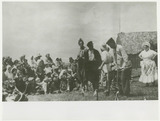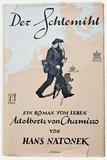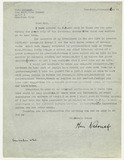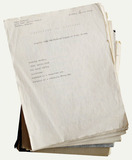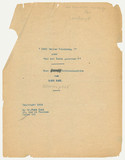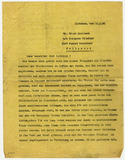Hans Hauska: photograph of a performance at the Deutsches Gebietstheater Dnjepropetrowsk (1935)
The musical comedy Where is Emily?Performing for the farmers during harvest time posed certain challenges for the programme of the Deutsches Gebietstheater Dnjepropetrowsk (German Regional Theatre Dnjepropetrowsk). Popular among the villagers were lively and comedic pieces in which they could find a reflection of their own daily life, albeit in somewhat exaggerated comic figures and scenarios.
Hans Natonek: Der Schlemihl (1936)
After the writer Hans Natonek had become stateless through denaturalisation and left only with his Jewish identity through the laws introduced by the Nazis, he grappled intensively with the meaning of identity. While still living in Germany, Natonek wrote the novel Der Schlemihl between early 1934 and autumn of the same year.
Hans Natonek: Letter to Hermann Kesten (24 October 1940)
The port city of Marseille became an important centre for refugees in the 1930s as ships bound for overseas locations called at the port. The refugees received assistance in travelling onwards from relief organisations such as the Emergency Rescue Committee.
Hans Natonek: Letter to the Emergency Rescue Committee (12 February 1941)
Job-seeking in exileWhen Hans Natonek arrived in New York with the refugee ship Excambion on 20 January 1941, he was 48 years old, had four dollars in his pocket and wondered to himself: “How many times can you start a new life?” (Serke, Böhmische Dörfer, 1987, p. 87)From the National Refugee Service he received an eight-dollar allowance per week, just enough to rent a small flat.
Hans Natonek: Unpublished works, typescripts (no year)
Hans Natonek's literary works in exile in the USDuring his exile in America, Hans Natonek first published some smaller works in 1941. Letzter Tag in Europa and Der erste Tag were published by the Aufbau publishing house.
Hans Purrmann: Interior with Two Women, probably completed in 1933
Hans Purrmanns works show the influence of many different artistic movements. Paul Cézanne, and the Expressionists and Fauvists provided artistic inspiration, yet elements of abstract art and Cubism are also discernible.
Hans Purrmann: Triptych for the council chamber in Speyer (1932)
In May 1931, Hans Purrmann was commissioned to design the front side of the district assembly's council chamber in Speyer. He decided on a triptych portraying an allegory of art and science.
Hans Sahl: Diary entry from 15 April 1941
Hans Sahl, who had garnered attention in Berlin in 1925 with his striking film and theatre reviews, actually wanted to be an author. His diary, which he began when he was living in Prague, the first city he lived in during his exile, in the following years became a medium for stylistic experimentation.
Hans Sahl: Film outline for 1000 Dollar Belohnung! (1939)
In 1938 Hans Sahl wrote a film script entitled 1000 Dollar Belohnung! while in France. It was a romantic comedy with Cinderella elements - the heroine is trying to find the person who saved her life from a jacket left behind at the scene of an accident.
Hans Sahl: Letter to Ernst Lubitsch (15 March 1941)
Before he left Europe for the United States on 1 April, 1941, Hans Sahl worked for several months in Marseille for Varian Fry and the Emergency Rescue Committee. Visas and affidavits needed to be procured and money and the ship passages had to be organised.
